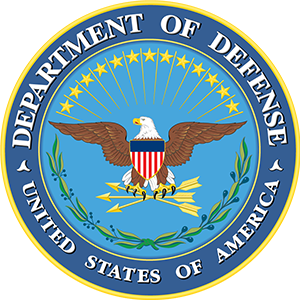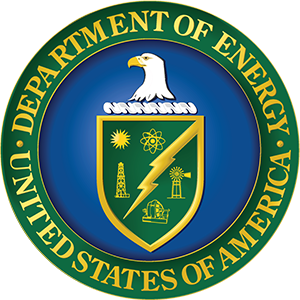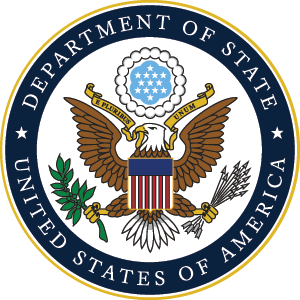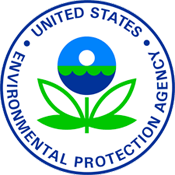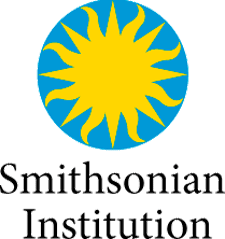Introduction
Within This Page
Sustainability has become an increasing priority for facilities projects. However, since the terrorist attacks of September 11, 2001 building owners and occupants have been paying more attention to facility security and safety issues. On the surface, it may appear that secure/safe design has little relationship to sustainable design. Yet, security and safety measures, such as those for anti-terrorism, must be considered within a total project context, including impacts on occupants and the environment, regardless of the level of protection deemed appropriate. Today's security design is based on a multi-hazard approach, that is, looking at the impact of all hazards on a project: natural, criminal, terrorist, chemical/biological, and accidental.
This Resource Page provides designers with an understanding of the interactions between security/safety and sustainability objectives by emphasizing the 'whole building' or integrated design process, identifying areas of synergy and potential conflicts between sustainable and security/safety approaches, and highlighting sustainability opportunities within certain security/safety strategies. With this information in hand, the project team can define and understand the interrelationships between the project's needs and achieve balanced design solutions that will minimize environmental impacts as well as ensure the health, safety, security, and comfort of building occupants.
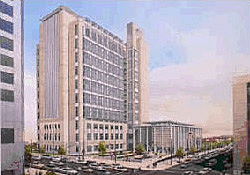
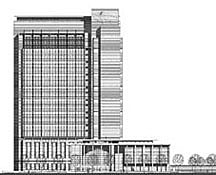
The Alfred A. Arraj United States Courthouse in Denver, Colorado serves as a model for designs that balances openness, security, and sustainability. The building showcases many sustainable strategies, including photovoltaic cells and daylighting using light shelves, while also being one of the first U.S. courthouses to meet the "GSA Security Design Criteria" standards.
Description
A. Integrated Design Process
It is important to understand that secure/safe, sustainable facilities don't just happen. The level of security/safety and sustainability incorporated in a facility varies greatly from project to project. But achieving quality, high performance facilities has a lot to do with an integrated process that identifies and embraces the goals of the project—including security/safety, sustainability, productivity, accessibility, functionality, aesthetics, historic preservation, and cost-effectiveness—early on. Working as a team from the outset, planners, designers, engineers, and all project stakeholders are able to develop creative solutions to design challenges that yield multiple benefits. For example, a massive, reinforced concrete wall can serve as blast protection for its occupants and a passive solar device saving energy during facility operation, resulting in a more secure, comfortable working environment. Also, rather than optimizing individual systems, the project team must understand that the most effective results can be obtained by designing various building systems and components as interdependent parts of the entire structure. This conceptual framework starts at the planning phase and is carried out through design and construction to building activation and operation. See also 'Whole Building' Approach and Aesthetics—Engage the Integrated Design Process.
B. Secure/Safe and Sustainable Trade-offs and Synergies
Given budgetary and other constraints, integrating secure/safe and sustainable design objectives oftentimes requires compromise and tradeoffs. For example, increasing glazing area to provide daylighting can be incompatible with the desire to decrease glazing to minimize glass hazard. Similarly, designating surface parking away from a building to provide appropriate stand-off distance can limit the extent to which a project can meet its site disturbance reduction goals. These inherent conflicts challenge the project team to find creative solutions for the issues at hand.
Following are key areas of interaction between security/safety and sustainability goals and measures. The project team is advised to evaluate the benefits and disadvantages of pursuing these strategies, weighing them against the project's identified requirements and desired outcome in order to achieve a balanced design. Engaging integrated design will greatly facilitate this process.
With today's concern about climate change and emphasis on significantly reducing energy consumption while reducing greenhouse gas emissions and carbon, it is more important than ever to incorporate secure/safe and sustainable trade-offs and synergies into building projects.
Site
Trade-Offs
Security and sustainable site planning strategies can significantly affect each other. For example, a facility's risk can be increased and security can be compromised by siting it in an urban area to protect greenfields and preserve habitat and natural resources; locating carpool/vanpool parking and bike racks nearby to promote alternative transportation; constructing under-building parking to minimize habitat disturbance; and installing covered walkways and landscaping to reduce heat islands and control erosion. On the other hand, security measures such as building setbacks, or standoff distances, to create protective building perimeters and to restrict access; installing barriers (e.g., bollards, reinforced planters, and site furnishings) to withstand assaults by moving vehicles; and locating parking areas in remote areas and/or eliminating under-building parking areas to minimize blast effects from potential vehicle bombs, usually result in increased development of open space, habitat disturbance, and possibly erosion.
Synergies
Erosion Control Measures: The erosion of soil caused by precipitation or wind can lead to destruction of vegetation, degradation of property, and sedimentation of local water bodies as well as unstable building foundations and potential loss of structural integrity. Erosion control measures can be implemented to stabilize the soil (e.g., seeding and mulching, installing pervious paving) and/or to retain sediment after erosion had occurred (e.g., earth dikes and sediment basins). These help to reduce the negative impacts on water and air quality as well as mitigate potential damage to a building's foundation and structural system due to floods, mudslides, torrential rainstorms, and other natural hazards. For more information on erosion control measures, see WBDG Achieving Sustainable Site Design through Low Impact Development Practices and Low Impact Development Technologies.
Landscaping: Keeping sustainability and safety goals in mind, designers can create landscaping schemes that can at once reduce environmental impacts and deter crime. For example, landscaping elements such as retention ponds and berms can be used to control erosion, manage stormwater, and reduce heat islands while also serving as physical barriers to control access to a building and to deflect the effects of a blast. Native or climate tolerant trees and plants help to improve the quality of the site as well as provide protection by obscuring assets and people. Note, however, that trees, large bushes, and shrubs, can also screen perpetrators from view. Crime Prevention Through Environmental Design (CPTED) is a set of strategies that uses natural access control, natural surveillance, and territoriality and boundary definition to reduce the opportunities and fear of predatory stranger to stranger crime and improve the quality of life. Early coordination of sustainable site design with CPTED is critical to avoid conflicts between the two strategies. For more information on landscaping, see WBDG Sustainable—Optimize Site Potential; Achieving Sustainable Site Design through Low Impact Development Practices and Low Impact Development Technologies.

Blocking sightlines
Water
Trade-Offs
- Rainwater Collection Systems: Typically, rain collection systems consist of stand-alone, exterior rain collection tanks located near a building. These tanks can create concealment opportunities and vulnerable areas, especially when they are located within the unobstructed space and/or minimum standoff distance. Consider integrating rainwater collection and storage systems into the architecture of the facility, such as the building facade. For more information on rainwater collection systems, see WBDG Water Conservation.
Synergies
Dry Fire Hydrants: One of the synergistic technologies for achieving water conservation and fire safety is a dry fire hydrant. Dry hydrants are non-pressurized suction pipe systems that are permanently installed in ponds or lakes and use the untreated water, instead of municipal water, to fight fires. Utilized in areas that lack conventional fire protection, areas that cannot handle the large volumes of water due to antiquated systems, or during peak use seasons when there is low water pressure, dry hydrants allow fire departments to be much more efficient by providing close water sources to fire risks. Since dry hydrants are installed below frost line and do not require electricity, they are capable of supplying water in the case of natural disasters such as hurricanes and tornadoes when electricity lines are knocked down, or during extreme cold or hot weather where conventional hydrant pipes can freeze or break. Also, dry fire hydrants help to save precious drinking water and conserve energy by using rainwater that does not need to be processed to be used for fighting fires. For more information, see The Dry Hydrant ConceptDownload dry_hydrants.pdf .
Constructed Wetlands: Constructed wetlands, used for wastewater treatment, can be incorporated into perimeter protection strategies to control vehicular and pedestrian access. For more information on constructed wetlands, see WBDG Achieving Sustainable Site Design through Low Impact Development Practices and Low Impact Development Technologies.
Energy
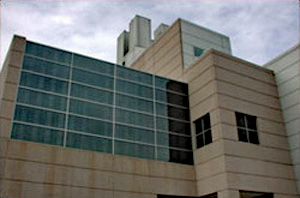
Trombe wall at NREL's Solar Energy Research Facility—Golden, Colorado
Trade-Offs
Because the opportunity to reduce load and employ energy efficiency measures is dependent on the chosen project site and site design, a site planned for security may not be optimal for energy conservation. The installation of onsite power generation and fuel supply for back-up power and/or increased power reliability may increase noise and development of open space as well as habitat disturbance. Also, additional equipment and systems needed to mitigate natural hazards, protect against fires, and defend against terrorist attacks will increase the building's energy loads and may affect its energy performance. The roof of covered parking facilities could be used to mount photovoltaic modules to provide quiet onsite power, while eliminating the need to use additional open space for power generation.
Synergies
Building Commissioning: Commissioning is the systematic process of ensuring and documenting that all building systems perform according to specification and design intent, consistent with the owner's operational needs. The goals of commissioning are to improve the building delivery process; to provide a safe and healthy facility; to improve energy performance; to reduce operating costs; to provide O&M staff orientation and training; and to improve systems documentation. According to the U.S. Green Building Council (USGBC), commissioning can improve new building energy performance by 8% to 30%. The more complex the building type and the more integrated the building systems, the more likely that a formal building commissioning process will prove valuable. Use commissioning to verify that the project's safety and sustainability goals have been achieved.
Integrated Building Automation and Control Systems (BAS): BAS integrates and automates traditionally stand-alone building automation and control systems such as HVAC, fire, lighting, and security systems into one comprehensive system. This enables electronic monitoring and control of air flow, space temperature, system performance, energy conservation, fire alarms, security functions, etc. from a single, centralized location for optimized building operations, energy efficiency, indoor comfort, safety, and security. For example, a BAS can be programmed such that a duct sensor can monitor the efficiency of the air flow, but can also detect a contaminant in the ductwork and alarm the facility manager who can then reconfigure the HVAC system in that part of the building, notify the proper officials, and evacuate occupants safely.
Renewable Distributed Energy Technologies: The use of renewable distributed energy technologies (e.g., wind turbines, photovoltaics, geothermal heat pump, and biomass gasifiers) reduces environmental impacts associated with utility energy production and use such as natural resources destruction, air pollution, and water pollution. They also offer consumers the potential for lower cost, higher service reliability, high power quality, increased energy efficiency, and energy security.
Thermal Mass Walls (Trombe Walls): Trombe walls are used to passively heat a space. A typical Trombe wall consists of an 8- to 16-inch thick masonry, stone, adobe, or concrete wall coated with a dark, heat-absorbing material and faced with a single or double layer of glass. The glass is placed from about 3/4" to 6" away from the wall to create a small airspace. Heat from sunlight passing through the glass is absorbed by the dark surface and stored in the wall. As it cools gradually during the night, it slowly releases its stored heat indirectly into the space. Trombe walls can serve double duty to reduce energy consumption and provide blast protection if they are integrated into the structural system and are made of reinforced concrete—masonry walls break up readily and become secondary fragments during blasts.
Window Films: Dangerous glass shards caused by natural hazards, accidents, or explosions can harm building occupants and visitors. Certain window films are designed to help hold shattered glass together, and make the glass stronger, and more resistant to breakage for improved safety and security. In addition, these films can reduce solar heat gain, glare, and fading for energy conservation and occupant comfort.
Materials
Trade-Offs
Buildings should be safe places to live and work. However, only a few buildings need to be Level 5 secure (critical to national security). To prevent unneeded security upgrades, hence use of more resources and materials, a comprehensive threat assessment, vulnerability assessment, and risk analysis must be conducted to identify the appropriate level of security for the building.
Synergies
There are some security and safety products made of materials with recycled content or other environmentally preferable characteristics. Examples include reinforced concrete site furniture made with slag (a by-product of steel production) and recycled content metal fencing (both could be used for perimeter access control).
Indoor Environmental Quality
Trade-Offs
Glazing and Daylighting: Daylighting improves indoor environment of buildings by exposing occupants to natural light. This can result in improved worker productivity and reduced energy costs. While daylighting can also contribute to the security of a building by shedding light on otherwise dark corners, it does increase the potential for glass hazard caused by natural disasters, accidents, or blast events. Size and locate windows with detonation points in mind. Understanding that extensive damage to conventional glazing can still result since blast pressures will wrap around buildings. Where appropriate, specify blast resistant glazing or window film that can also reject heat and glare. Avoid exterior ornamentation, including certain sun control and shading devices, that can break away easily. Also, note that the placement of windows and doors to allow for good visibility and surveillance may interfere with daylighting schemes.
Natural Ventilation vs. Mechanical Ventilation: Natural ventilation has become an increasingly energy-efficient and attractive method for providing acceptable indoor air quality and maintaining a healthy, comfortable, and productive indoor climate rather than the more prevailing approach of using energy-intensive mechanical ventilation. Power sources are not needed to operate natural ventilation systems, so building occupants can maintain their level of comfort in the event of power shortages or blackouts. On the other hand, natural ventilation systems could bring outside contaminants inside. For critical and high-risk buildings, mechanical ventilation with special filters is recommended to protect against possible chemical, biological, and radiological (CBR) agents from entering interior spaces. Although more energy will be used, mechanical ventilation does allow for precise control of humidity, preventing the growth of mold and mildew. Under-floor air distribution systems should not be used in laboratories or other spaces containing hazardous materials that could spill onto the floor and contaminate the under-floor air.
Synergies
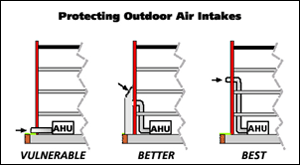
Protecting outdoor air intakes
Dedicated Ventilation and/or Exhaust Systems: Exposure of building occupants to potentially hazardous chemical, biological, and radiological (CBR) agents negatively impacts the indoor environment and can pose serious health threats. To help maintain superior indoor air quality and protect people's health, dedicated ventilation systems (aka. dedicated outdoor air systems [DOAS]) and dedicated exhaust systems can be installed. DOAS use separate air handlers to condition and deliver the minimum required constant volume of outdoor air. Be sure to protect all outdoor air intakes and locate discharge points away from them (see Figure to the right). For more information, see the Department of Health and Human Services / National Institute for Occupational Safety and Health publications Guidance for Protecting Building Environments from Airborne Chemical, Biological, or Radiological Attacks, May 2002 and Guidance for Filtration and Air-Cleaning Systems to Protect Building Environments from Airborne Chemical, Biological, or Radiological Attacks, April 2003.
Tight Building Envelope: In traditional construction, infiltration occurs through gaps and cracks in the building envelope. Excess infiltration of cold air in the winter and hot humid air during the summer can create uncomfortable indoor environments, including mold and mildew and raise heating and cooling costs by 20% to 40%. Such unintentional infiltration is also a concern for an exterior chemical, biological, and radiological (CBR) release at some distance from a building, such as a large-scale attack. Decreasing infiltration improves comfort, saves energy, controls moisture, reduces indoor pollution, and promotes ventilation. Also, tight building construction in combination with building pressurization can be an effective CBR-protection strategy.
C. Sustainable Design Considerations and Opportunities
The table below identifies sustainable design considerations and opportunities when employing various safe design strategies.
| Safety and Security Strategies | Sustainable Design Considerations/Opportunities |
|---|---|
| Access Control* | |
| Secure site perimeter | Integrate with sustainable landscaping scheme. See WBDG Sustainable—Optimize Site Potential and Achieving Sustainable Site Design through Low Impact Development Practices. |
| Use barriers to prevent passage of vehicles | Use natural and/or environmentally friendly barriers (e.g., trees, retention ponds, etc.). Use reinforced site furniture, planters, etc. as vehicle barriers. See WBDG Achieving Sustainable Site Design through Low Impact Development Practices and Low Impact Development Technologies. |
| Minimize public entrances into the building | Integrate with daylighting scheme. |
| Secure vulnerable openings (e.g. doors, first floor windows) | Integrate with daylighting scheme. |
| Install electronic access systems (e.g., parking, elevators) | Use energy-efficient systems. Consider renewable and/or distributed energy resources. See WBDG Building Integrated Photovoltaics, Distributed Energy Resources, Fuel Cell Technology, Microturbines. |
| Secure critical functions (e.g., IT, mechanical systems) | Consider dedicated ventilation and/or exhaust systems. |
| Surveillance* | |
| Locate windows and doors to allow for good visibility | Integrate with daylighting scheme. |
| Avoid spaces that permit concealment | Integrate with daylighting scheme. |
| Define public versus private interior zones | Use signage and other directional devices manufactured from recycled material. Use barriers with low-VOC or no VOC finishes. |
| Avoid blocking lines of sight with fencing and landscaping | Integrate with landscaping and daylighting schemes. |
| Locate public areas (e.g., restrooms) where they can be easily observed | Integrate with water and energy efficient restroom fixtures scheme. |
| Design lighting to reinforce natural surveillance | Integrate with building automation and control systems. Use energy-efficient systems. Consider renewable and/or distributed energy sources, such as solar power night lighting. See WBDG Building Integrated Photovoltaics, Distributed Energy Resources, Fuel Cell Technology, Microturbines. |
| Install intrusion devices and video systems | Integrate with building automation and control systems. Use energy-efficient lighting and controls. Use low-light or no-light cameras for scene observation that minimize/eliminate the need for electrical lighting. Consider renewable and/or distributed energy sources. |
| Use screen and tracking systems | Integrate with building automation and control systems. Use energy-efficient lighting. Consider renewable and/or distributed energy sources. |
| Blast Protection* | |
| Design structural systems to prevent or delay building collapse | Integrate with passive solar design (e.g., Trombe walls). Use sustainable materials (e.g., fly-ash concrete, slag concrete, steel columns, etc.). |
| Use building configurations to better resist blast shock waves | Integrate with passive solar design and daylighting scheme. |
| Maximize distances between parking and buildings | Integrate with alternative transportation plans. |
| Size and locate windows with detonation points in mind | Integrate with daylighting scheme. Specify glazing or window films that reduce heat gain and glare and provide blast protection. |
| Use blast or ballistic resistant glazing | Use blast or ballistic resistant window films that are also energy-efficient (reduce heat gain and glare). |
| Increase strength of exterior cladding and nonstructural elements | Use sustainable materials. Consider thermal benefits of strengthened cladding options. |
| Avoid exterior ornamentation that can break away | Integrate with sun control and shading devices. |
| Chemical, Biological, Radiological Protection*. | |
| Elevate fresh air intakes | Integrate with energy-efficient HVAC system. |
| Prevent unauthorized access to fresh-air intakes | Specify bars and grates to be manufactured with recycled steel. |
| Reduce need for utilities | Consider renewable such as daylighting, passive solar heating, photovoltaics, and geothermal; and/or distributed energy resources. |
| Apply external air filtration and overpressurization techniques | Integrate with building automation and control systems. |
| Use internal air filtration technologies | Integrate with building automation and control systems. |
| Secure vulnerable areas (e.g., mail rooms, loading docks, mechanical rooms, storage) | Consider dedicated ventilation and/or exhaust systems. |
| Establish mail-handling protocols and procedures | Utilize energy efficient equipment, machinery, and lighting. |
| Establish emergency plans for biochemical attacks | Consider dedicated ventilation and/or exhaust systems. |
| Energy Security* | |
| Create redundant systems | Reduce energy loads. Use energy-efficient systems. Consider renewable and/or distributed energy resources. |
| Occupant Safety and Health** | |
| Provide designs that eliminate or reduce hazards in the work place to prevent mishaps | Integrate safety mechanisms with sustainable features. Use integrated building automation and control systems. |
| Prevent occupational injuries and illnesses | Consider integrated natural and mechanical ventilation systems. Use integrated building automation and control systems. |
| Prevent falls from heights | Use sustainable materials for guardrails and barriers. Operable windows should have safety measures to prevent falls. |
| Prevent slips, trips, and falls | Integrate daylighting into illumination scheme. Use LED lamps and fixtures. Use electroluminescent devices which require no source of electricity. |
| Ensure electrical safety | Follow standards and recommended practices for installing and operating photovoltaic systems and distributed energy resources, such as fuel cells and microturbines. |
| Eliminate exposure to hazardous materials (e.g., volatile organic compounds (VOCs) and formaldehyde, lead, and asbestos in older buildings) | Use sustainable materials (e.g., no-VOC paints, adhesives, and sealants, formaldehyde-free finish panels, etc.). Use dedicated ventilation and/or exhaust systems in copy rooms, labs, loading docks, and mailrooms. |
| Provide good indoor air quality (IAQ) and adequate ventilation | Use daylighting. Consider integrated natural and mechanical ventilation systems. Use integrated building automation and control systems. |
| Provide ergonomic work places to prevent work-related musculoskeletal disorders (WMSD) | Use sustainable materials, including furnishings with recycled content, recyclable or compostable materials, and reconditioned furniture. |
| Perform proper building operations and maintenance | Implement total building commissioning. Use integrated building automation and control systems. |
| Provide for proper receiving, storing, and handling of consumable materials | Implement total building commissioning. |
* Source: Building Security Through Design: A Primer for Architects, Design Professionals, and their Clients by The American Institute of Architects. Washington, DC: AIA, p. 15. ** Source: WBDG Safe—Ensure Occupant Safety & Health
Application
Examples
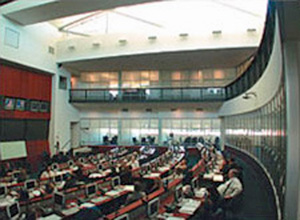
California's Office of Emergency Services Headquarters—Sacramento, California. Photo Credit: enr.com and archrecord.construction.com
California's Office of Emergency Services Headquarters, Sacramento, California: Located on a 12-acre site, the complex is the anchor project for the adaptive reuse of the former Mather Air Force Base. It exemplifies the newest generation of open yet secure, safe, and sustainable buildings. Strategies and features include: use of landform to control vehicular access; open, daylit spaces for comfortable, productive work environments; and back-up fuel supply for energy security.
Pictured on right: Break out rooms surround the command and logistics room, shielding it from exposure to the outside, although clerestories allow a generous amount of daylight to enter the space.
Williams Communications' Headquarters, Tulsa, Oklahoma: At the core of the Williams Communications' headquarters building is a 47,000 sf highly secure network operations center that provides a spacious, daylit, dynamic work environment for its occupants.
Defense Intelligence Analysis Center (DIAC), Bolling Air Force Base, Washington, DC: The approximately $100 million project is a first-class, six story 450,000 sf office building designed to consolidate uniquely skilled intelligence personnel currently working in lease spaces throughout the region. Connected to an existing building via a corridor, the project successfully integrates security and sustainability features within the design, creating an energy-efficient, comfortable, yet very secure facility. For example, the design of the facility takes advantage of the earth berm behind so it would be able to withstand impact by a truck traveling at 40 MPH.
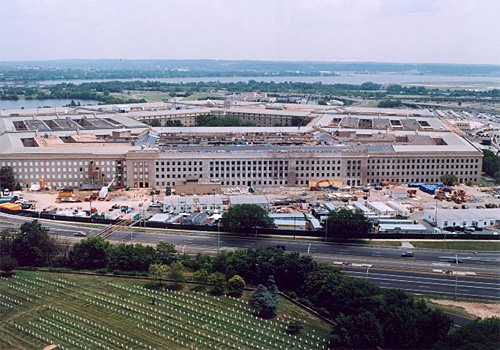
Pentagon renovations
Pentagon Renovation, Arlington, Virginia: The energy management control system installed to efficiently manage the heating, cooling, and lighting systems throughout the Pentagon allowed officials to manipulate all the building systems in the first minutes after the 9/11 terrorist attack. This minimized the areas of the building that had to be entered to operate equipment, reducing risks to employees. Also, the Pentagon's new windows, installed for security and energy efficiency benefits, helped to contain damage from the attack.
Oklahoma City Federal Building, Oklahoma City, Oklahoma: The 181,000sf facility replaced the Alfred P. Murrah Federal Office Building, which was destroyed by a bomb in 1995. As the owner, the U.S. General Services Administration (GSA) wanted the building to be transparent, open, and accessible to public as well as secure and sustainable. One of the primary strategies was using landscaping, including light fixtures and other streetscape items, to provide the appropriate setback distance and to serve as security barriers. For more information, see "Secure and Sustainable" by Gordon Wright. Building Design and Construction.
Relevant Codes and Standards
Federal Mandates
- Code of Federal Regulations, 10 C.F.R. § 434 "Energy Code for New Federal Commercial and Multifamily High-Rise Residential Buildings"
- Energy Independence and Security Act of 2007
- Energy Policy Act of 2005 (EPACT)
- Executive Order 12656, "Assignment of Emergency Preparedness Responsibilities"
- Executive Order 12977, "Interagency Security Committee"
- Executive Order 13693, "Planning for Federal Sustainability in the Next Decade"
- Executive Order 14057, "Catalyzing Clean Energy Industries And Jobs Through Federal Sustainability", a broad sustainability plan for federal buildings and operations that includes "buy clean" provisions and the goal for all federal buildings to have net zero emissions by 2045 and a 50% emissions reduction from buildings by 2032.
Standards and Guidelines
- Air Force
- Air Force Sustainable Design and Development (SDD) Implementing Guidance MemorandumDownload af_sdd_impl_guidance.pdf , 02 June 2011. Signatory: Maj Gen Timothy A. Byers, USAF, The Civil Engineer, DCS/Logistics, Installations & Mission Support
- Army
- Army Memorandum: Sustainable Design and Development Policy Update, 16 December 2013. Signatory: Katherine Hammack, Assistant Secretary of the Army (Installations, Energy and Environment)
- FM 3-19.30 Physical Security—Sets forth guidance for all personnel responsible for physical security.
- Department of Defense
- UFC 1-200-02 High Performance and Sustainable Building Requirements
- UFC 3-210-10 Low Impact Development
- UFC 4-010-01 DoD Minimum Anti-Terrorism Standards for Buildings
- UFC 4-024-01 Security Engineering: Procedures for Designing Airborne Chemical, Biological, and Radiological Protection for Buildings
- Department of Health and Human Services
- Department of Homeland Security
- Federal Emergency Management Agency (FEMA)
- General Services Administration
- Department of Homeland Security
Additional Resources
Federal Agencies
- Department of Defense
- Others
Publications
- "Building for a Secure Future: Bioterrorism" by Engineering News-Record and Architectural Record. Available: enr.com and archrecord.construction.com (03/25/02 issue)
- Building Security Through Design: A Primer for Architects, Design Professionals, and their ClientsDownload aiab086647.pdf by The American Institute of Architects. Washington, DC: AIA.
- Greening Federal Facilities Guide by U.S. Department of Energy, 2001.
- Protection of Federal Office Buildings Against Terrorism by the Committee on the Protection of Federal Facilities Against Terrorism, Building Research Board, National Research Council. Washington, DC: National Academy Press, 1988.
- Securing Buildings and Saving Energy: Opportunities in the Federal SectorDownload security_sustain_whitepaper_final_12aug.pdf by Jeffrey Harris, William Tschudi, and Beverly Dyer. U.S. Department of Energy Federal Energy Management Program
Organizations
- The American Institute of Architects (AIA)
- American Society of Civil Engineers (ASCE)
- American Society of Landscape Architects (ASLA)
- ASIS International
- Building Security Certifcation Program (BSCP)
- International Living Future Institute
- International Well Building Institute
- Protective Glazing Council (PGC)
- Society of American Military Engineers (SAME)
- Sustainable Sites Initiative
- The Infrastructure Security Partnership (TISP)
- U.S. Green Building Council (USGBC)
Rating Systems
- Green Globes—Green Globes® is a science-based, three-in-one building rating system that evaluates the environmental sustainability, health, wellness, and resilience of commercial buildings and portfolios.
- Leadership in Energy and Environmental Design (LEED®)—LEED is a third party certification program for the design, construction and operation of high performance green buildings.
- Living Building Challenge (LBC)—LBC is a philosophy, advocacy tool, and certification program defining the most advanced measure of sustainability in the built environment.
- SITES Rating System—provides a comprehensive framework for designing, developing, and managing sustainable and resilient landscapes and other outdoor spaces and is the ideal tool to support nature positive design.
- WELL Building Standard™—The WELL Building Standard version 2 (WELL v2™) is a vehicle for buildings and organizations to deliver more thoughtful and intentional spaces that enhance human health and well-being.

